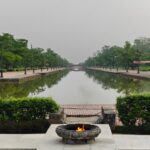Introduction
South Korea’s extraordinary transformation from an agrarian economy in 1960 to one of the world’s fastest-growing economies by the late 1980s offers invaluable lessons for developing nations. Led by President Park’s strategic vision, South Korea’s economic journey highlights the importance of government intervention, a balanced economic approach, and careful regulation of foreign capital. Exploring essential aspects of South Korea’s growth, we can uncover insights that can help guide Nepal’s path to economic prosperity.
Central to South Korea’s rapid economic rise was President Park’s visionary approach, which prioritized robust economic growth as the cornerstone of national development. Under his leadership, the government played a pivotal role in steering the economy towards a trajectory of sustained expansion. Unlike laissez-faire models, South Korea’s developmental strategy involved a mix of market incentives and direct government intervention. This interventionist approach, while not dismissive of private enterprise, emphasized a collaborative relationship between the government and businesses. Private enterprises were expected to operate in tandem with governmental guidance and contribute to the broader national economic goals. This nuanced balance between public and private sectors became a hallmark of South Korea’s development model.
Key Policies
Balanced Economic Strategies and Export-Led Growth: In contrast to the conventional debate between export promotion and import substitution, South Korea’s developmental model embraced a balanced approach. President Park Chung Hee’s administration emphasized both exports and import substitution, leading to a significant increase in export contributions from 2.4% of Gross National Product (GNP) in 1962 to 31% in 1979. Efforts to address biases against exports involved measures such as currency devaluation, the establishment of a free trade regime for exports, and the removal of indirect taxes on domestic inputs utilized for export purposes.
Diversification: South Korea’s transition from an agrarian economy in 1960 to a manufacturing powerhouse by the late 1980s exemplifies the success of a strategic government-led approach. President Park Chung Hee prioritized economic growth, with gross investment soaring from 12.8% in 1962 to 35.7% in 1979. The shift towards manufacturing not only bolstered GDP but highlighted the effectiveness of a balanced strategy, where government intervention played a vital role in driving economic expansion.
Regulation of Foreign Capital: Then President Park Chung Hee’s government demonstrated the efficacy of direct intervention and regulation in shaping economic activities. Rather than relying solely on market mechanisms, strategic government initiatives identified key industries for promotion and allocated resources accordingly. Notably, the careful regulation of foreign direct investment (FDI) indicates a pragmatic approach. While encouraging FDI selectively, approvals were granted based on national interests, ensuring that economic development goals were safeguarded.
Outlook for Nepal
Capitalizing on South Korea’s success, Nepal has a prime opportunity to strengthen the collaboration between the government and private enterprises. South Korea’s success story highlights how the government, under President Park Park Chung Hee’s leadership, strategically intervened to support and guide private enterprises. By providing targeted incentives, guidance, and a conducive environment, the government can empower and energize the private sector. Policies should be crafted to incentivize innovation, entrepreneurship, and investment, ensuring that the private sector becomes a dynamic engine of economic progress. By aligning government interventions with the interests and needs of the private sector, Nepal can set the stage for a sustainable and inclusive economic transformation. Shifting from an agrarian-based economy to an industrial one requires a strategic and coordinated effort, where government intervention plays a pivotal role. As Nepal aims to graduate from the least developed country status in 2026, Korean Ambassador Tae-Young Park expressed a commitment to assist Nepal in climbing the economic ladder during an event organized on September 27, 2023, in Kathmandu. This signals a promising partnership for economic advancement, fostering optimism and collaboration between the two nations.
Ayusha Kunwar holds a Bachelor of Science in Economics from Northeastern University with a keen interest in international economics, public policy, and development economics. Currently, she is an intern at the Nepal Economic Forum(NEF).





